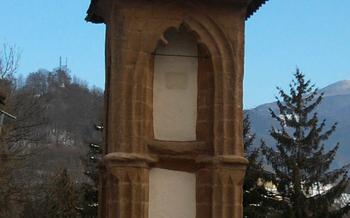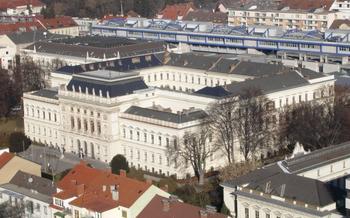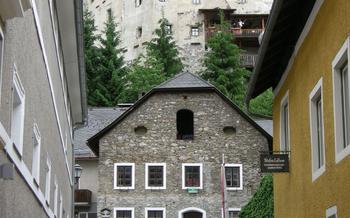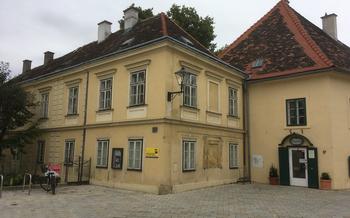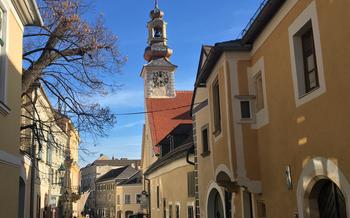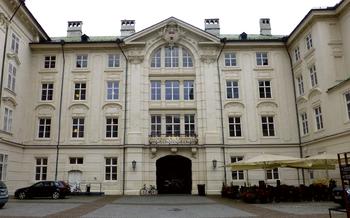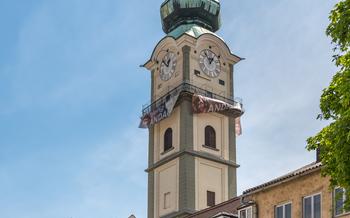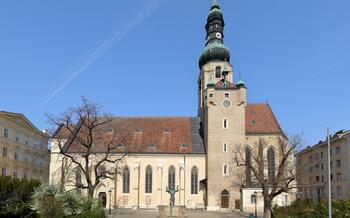
St. Giles' Cathedral (Stadtpfarrkirche)
- St. Giles' Cathedral: A Historical Overview
- Exploring the Cathedral's Exterior
- Stepping Inside the Grand Interior
- The Splendid Altars and Chapels
- Marveling at the Stunning Stained Glass Windows
- Unveiling the Crypts and Catacombs
- Witnessing the Impressive Organ
- Attending a Mass or Concert
- Discovering the Cathedral's Treasury
- Exploring the Cathedral Square
- Uncovering the Graz Mausoleum
- Visiting the Diocesan Museum Graz
- Tips for Planning Your Visit
- Respecting Religious Customs and Etiquette
St. Giles' Cathedral: A Historical Overview
Graz's St. Giles' Cathedral, a magnificent edifice that stands as a testament to centuries of architectural brilliance and religious devotion, invites you on a journey through time. Its origins can be traced back to the 12th century, when a Romanesque church stood on the same site. As the city flourished, so did the need for a grander house of worship, leading to the construction of the Gothic cathedral in the 15th century.
The cathedral's architectural styles reflect the evolution of artistic sensibilities. The exterior boasts intricate Gothic elements, characterized by pointed arches, ribbed vaults, and elaborate buttresses. The interior, however, reveals a harmonious blend of Gothic and Baroque styles, showcasing ornate altars, delicate carvings, and stunning stained glass windows.
Throughout history, St. Giles' Cathedral has been intertwined with significant events and influential figures. It served as the imperial court church during the reign of Emperor Frederick III, who frequently attended mass within its hallowed halls. The cathedral also witnessed the coronation of Archduke Ferdinand II as King of Bohemia in 1617, a pivotal moment in the history of the Habsburg dynasty.
St. Giles' Cathedral has played an integral role in the religious and cultural life of Graz. It remains a vibrant center of worship for the Catholic community, hosting regular masses, ceremonies, and religious festivals. Beyond its spiritual significance, the cathedral has become a symbol of Graz's rich history, attracting visitors from around the world who come to marvel at its architectural grandeur and immerse themselves in its sacred atmosphere.
Exploring the Cathedral's Exterior
The exterior of St. Giles' Cathedral is a testament to the architectural prowess and artistic vision of its builders. The façade, adorned with intricate carvings and sculptures, invites visitors to delve into the rich history and symbolism embedded within its walls. The main entrance, framed by an elaborate Gothic arch, serves as a grand portal to the sacred space within.
Notable features of the exterior include the towering bell tower, which dominates the skyline and houses a set of harmonious bells that chime melodiously throughout the city. The buttresses, with their sturdy design, lend support to the cathedral's structure and add a sense of strength and stability. Gargoyles, with their whimsical and grotesque expressions, adorn the eaves, serving both as decorative elements and functional waterspouts.
The exterior decorations are imbued with deep symbolism and fascinating stories. The intricate carvings depict scenes from the Bible, saints, and mythical creatures, each with its unique narrative. These carvings serve as a visual testament to the beliefs and values of the medieval society that built the cathedral.
The overall impression of St. Giles' Cathedral's exterior is one of awe and grandeur. Its intricate details, harmonious proportions, and symbolic decorations captivate visitors, leaving an enduring impression of its architectural and historical significance.
Stepping Inside the Grand Interior
As you step through the grand entrance of St. Giles' Cathedral, a sense of awe and tranquility washes over you. The cathedral's interior is a testament to the skill and devotion of its builders, with every inch adorned with intricate carvings, stunning stained glass windows, and soaring arches.
The nave, the central aisle of the cathedral, is a breathtaking sight. Its high vaulted ceiling, supported by slender columns, creates a sense of vastness and grandeur. The walls are lined with side altars, each dedicated to a different saint or religious figure. The intricate carvings and colorful paintings on these altars tell stories from the Bible and the lives of the saints, inviting visitors to contemplate their faith and devotion.
The transepts, the arms of the cathedral that extend from the nave, are equally impressive. They house additional altars, chapels, and notable works of art. The high altar, located at the far end of the nave, is a masterpiece of Baroque art, with its elaborate carvings, gold leaf, and vibrant colors. It is a focal point for religious ceremonies and a symbol of the cathedral's rich history.
The overall impression of the cathedral's interior is one of grandeur, beauty, and spirituality. It is a place where visitors can come to worship, reflect, and connect with their faith. Whether you are a devout Catholic, a history enthusiast, or simply an admirer of beautiful architecture, the interior of St. Giles' Cathedral is sure to leave you inspired and awestruck.
The Splendid Altars and Chapels
The interior of St. Giles' Cathedral is adorned with a series of magnificent altars and chapels, each boasting unique designs, intricate details, and profound historical significance. The high altar, the centerpiece of the cathedral, captivates visitors with its towering presence, adorned with exquisite carvings, gold leaf embellishments, and a stunning altarpiece depicting scenes from the life of St. Giles.
Among the notable side altars, the Altar of the Assumption stands out with its intricate carvings depicting the Virgin Mary's ascent to heaven. The Altar of St. John of Nepomuk, dedicated to the patron saint of bridges, features a beautiful statue of the saint and scenes from his life. The Altar of the Holy Cross, with its poignant crucifix, invites visitors to reflect on the sacrifice of Jesus Christ.
The chapels within the cathedral offer intimate spaces for prayer and contemplation. The Chapel of St. Anthony, located behind the high altar, houses a revered statue of the saint and is a popular destination for pilgrims seeking his intercession. The Chapel of the Holy Sepulcher, with its life-size figures depicting the crucifixion and resurrection of Jesus, creates a deeply moving and immersive experience.
These altars and chapels, with their artistic masterpieces and profound symbolism, serve as reminders of the rich spiritual heritage of St. Giles' Cathedral and continue to inspire awe and devotion among visitors from all walks of life.
Marveling at the Stunning Stained Glass Windows
The St. Giles' Cathedral is renowned for its exquisite stained glass windows, which adorn the interior with vibrant colors and intricate designs. These magnificent windows, created by skilled artisans over centuries, depict biblical scenes, saints, and other religious motifs. The oldest stained glass windows date back to the 14th century and showcase the Gothic style, with their elongated figures and rich, deep hues. As you gaze upon these windows, you can imagine the awe and wonder they must have inspired in medieval worshippers.
In the 19th century, the cathedral underwent a major restoration, during which many of the original stained glass windows were replaced with new ones. These newer windows, crafted in the Neo-Gothic style, feature brighter colors and more detailed representations of biblical scenes. The most striking of these is the large rose window above the main entrance, which depicts the Coronation of the Virgin Mary, surrounded by a chorus of angels.
The stained glass windows of St. Giles' Cathedral not only enhance the beauty of the interior but also serve as a powerful teaching tool. They illustrate stories from the Bible, reminding visitors of the life, teachings, and sacrifice of Jesus Christ. The windows also depict the lives of saints and martyrs, inspiring worshippers to follow their example of faith and devotion.
As sunlight streams through the stained glass windows, the cathedral is transformed into a kaleidoscope of colors. The shimmering light dances upon the stone walls, creating an ethereal and awe-inspiring atmosphere. Whether you are a religious pilgrim or simply an art enthusiast, the stained glass windows of St. Giles' Cathedral are a sight to behold.
Unveiling the Crypts and Catacombs
Beneath the grandeur of St. Giles' Cathedral lie hidden depths that evoke both intrigue and reverence. The cathedral's crypts and catacombs form a subterranean realm steeped in history and mystery, inviting visitors to explore the final resting places of notable figures from Graz's past.
The crypts, located beneath the cathedral's main altar, house the remains of bishops, priests, and other prominent religious figures who have served the diocese throughout the centuries. Elaborate tombs and epitaphs adorn the crypt walls, each telling a story of faith, devotion, and service.
Descending further into the depths, visitors can explore the cathedral's catacombs, a network of tunnels and chambers that once served as a burial ground for the city's elite. Here, visitors can encounter the skeletal remains of past generations, offering a poignant reminder of the fragility and transience of life.
Symbolism and rituals surround the crypts and catacombs, adding to their mystique. The crypts are often adorned with imagery of resurrection and eternal life, while the catacombs were once the site of solemn ceremonies and rituals honoring the dead.
The eerie and fascinating atmosphere of these underground spaces transports visitors back in time, evoking a sense of awe and contemplation. The crypts and catacombs serve as a reminder of the rich history and enduring legacy of St. Giles' Cathedral, weaving together the threads of faith, remembrance, and the enduring human spirit.
Witnessing the Impressive Organ
At the heart of St. Giles' Cathedral, a magnificent organ stands as a testament to the harmonious union of art and spirituality. This monumental instrument, boasting a rich history and unparalleled craftsmanship, is a sight to behold and a sound to cherish.
Towering over the nave, its intricate facade adorned with carvings and gilded embellishments, the organ captivates the eye with its sheer grandeur. Its imposing presence commands attention, hinting at the symphony of sounds that await the listener.
Crafted by renowned organ builders with meticulous care, the instrument comprises thousands of pipes, each meticulously tuned to produce a diverse range of tones and timbres. The console, with its array of manuals and pedals, resembles a conductor's podium, inviting skilled musicians to unleash the organ's full potential.
During religious ceremonies, the organ's majestic voice fills the cathedral with sacred melodies, accompanying the congregation in their hymns of praise and devotion. Its resonant tones reverberate through the grand space, creating an atmosphere of solemnity and awe.
Beyond its liturgical role, the organ is also a centerpiece for musical performances of the highest caliber. Renowned organists from around the world grace the cathedral with their artistry, presenting intricate compositions that showcase the instrument's versatility and expressive range.
The acoustics of the cathedral, with its soaring vaults and reverberant surfaces, provide the ideal setting for the organ's music to unfold its full glory. Each note resonates with crystal clarity, creating a captivating soundscape that envelops the listener in a mesmerizing embrace.
Whether accompanying the faithful in prayer or showcasing the talents of virtuoso performers, the organ of St. Giles' Cathedral stands as a symbol of musical excellence and spiritual harmony, leaving an indelible mark on every visitor who experiences its majestic presence.
Attending a Mass or Concert
St. Giles' Cathedral welcomes visitors and locals alike to attend mass services and concerts held throughout the year. Masses are conducted in German and sometimes in other languages on special occasions. Visitors are encouraged to check the cathedral's website or inquire at the information desk for specific mass schedules and languages.
The mass experience at St. Giles' Cathedral is uplifting and spiritually enriching. The grand interior, filled with the melodious sounds of the organ and choir, creates a sacred and serene atmosphere. Visitors can immerse themselves in the rituals, prayers, and readings, feeling a sense of connection to the local community and the cathedral's rich history.
In addition to mass services, the cathedral hosts various concerts and musical performances. These events showcase the talents of local and international musicians, presenting a diverse repertoire of sacred and secular music. Visitors can enjoy the exquisite acoustics of the cathedral, which enhance the musical performances and create a truly captivating experience.
Attending a mass or concert at St. Giles' Cathedral is an opportunity to not only witness the beauty and grandeur of the cathedral but also to connect with the spiritual and cultural traditions of Graz. Whether seeking a moment of contemplation or an evening of musical delight, visitors are sure to be moved and inspired by their experience.
Discovering the Cathedral's Treasury
Delve into the depths of St. Giles' Cathedral and uncover its hidden treasure trove, the cathedral treasury. This sacred repository is a testament to the cathedral's rich history and enduring legacy. Step inside and be awed by the exquisite collection of religious artifacts, relics, and manuscripts that have been meticulously preserved for centuries.
Among the many treasures, marvel at the intricate gold and silver chalices, each adorned with precious stones and delicate engravings. Admire the finely crafted vestments, intricately embroidered with biblical scenes and symbols, once worn by the cathedral's clergy during solemn ceremonies. Pore over ancient manuscripts, their pages illuminated with vibrant colors and intricate calligraphy, whispering tales of faith and devotion.
Each item in the treasury holds a profound symbolic meaning, representing the cathedral's unwavering faith and connection to the divine. Discover the stories behind these treasured objects, as they illuminate the lives of the saints, martyrs, and benefactors who have shaped the cathedral's legacy.
The treasury is not merely a collection of artifacts; it is a living testament to the enduring power of faith and the enduring spirit of St. Giles' Cathedral. As you explore this sacred space, feel the weight of history and tradition that envelops you, reminding you of the profound role that religion has played in shaping the cultural and spiritual identity of Graz.
Exploring the Cathedral Square
The heart of Graz's religious center, Cathedral Square, is a picturesque and historically significant space that surrounds the majestic St. Giles' Cathedral. This lively square, pulsating with life, invites visitors to delve into its rich past and admire its architectural wonders.
In the center of the square stands the Plague Column, a soaring monument erected in 1680 as a testament to the city's resilience during the devastating plague that swept across Europe. Its intricate carvings depict scenes of suffering and divine intervention, serving as a poignant reminder of the city's triumph over adversity.
The square is graced by a harmonious blend of architectural styles, with historic buildings lining its cobbled streets. Notable structures include the Old Town Hall, with its elegant Renaissance façade, and the enchanting Alte Universität, the former university building that now houses the Styrian State Archives.
Amidst the square's vibrant energy, street performers entertain visitors with their talents, while markets and events add to the lively atmosphere. The square transforms into a bustling hub of activity, where locals and tourists mingle, creating a vibrant tapestry of human interactions.
Cathedral Square stands as a testament to Graz's rich history, seamlessly blending the sacred and the secular. Its charm lies in its ability to transport visitors back in time while offering a glimpse into the city's vibrant present.
Uncovering the Graz Mausoleum
In the heart of Graz, just a stone's throw from St. Giles' Cathedral, lies the Graz Mausoleum, a captivating architectural gem steeped in history and intrigue. Built in the 16th century by Emperor Ferdinand II as a final resting place for himself and his family, the mausoleum stands as a testament to the power and prestige of the Habsburg dynasty.
With its striking Renaissance facade and elaborate interior decorations, the mausoleum is a true masterpiece of its time. Visitors are awed by the intricate carvings, ornate frescoes, and magnificent stained glass windows that adorn its walls and ceilings. The mausoleum houses the remains of several Habsburg rulers, including Emperor Ferdinand II, his wife, and their children.
As you step inside the mausoleum, you'll be struck by the serene and contemplative atmosphere that envelops the space. The soft light filtering through the stained glass windows casts a warm glow on the marble statues and gilded sarcophagi, creating a sense of awe and reverence.
Take a moment to admire the exquisite craftsmanship of the mausoleum's interior. The walls are adorned with intricate carvings depicting biblical scenes and allegorical figures, while the ceiling features stunning frescoes that seem to float weightlessly overhead. The elaborate sarcophagi, each adorned with unique sculptures and inscriptions, tell the stories of the Habsburg rulers who lie in eternal rest within.
The Graz Mausoleum is not just a historical landmark but also a place of deep cultural and religious significance. It serves as a reminder of the Habsburg dynasty's profound influence on the city of Graz and the region as a whole. Whether you're a history buff, an art enthusiast, or simply someone seeking a moment of tranquility, the Graz Mausoleum is an unmissable destination that will transport you back in time and leave you with a lasting sense of wonder.
Visiting the Diocesan Museum Graz
Adjacent to the St. Giles' Cathedral, the Diocesan Museum Graz stands as a treasure trove of religious art and history. Established in 1951, the museum houses an extensive collection of artifacts and artworks that provide insights into the rich Catholic heritage of the region.
The museum's exhibits are arranged chronologically, taking visitors on a journey through the history of the diocese from its early beginnings to the present day. Highlights include medieval sculptures, paintings, and liturgical objects, such as intricately crafted chalices, monstrances, and vestments.
Among the most notable pieces are the late Gothic altarpiece from the former Augustinian monastery in Seckau, which depicts scenes from the life of Christ, and the Baroque paintings by Johann Martin Schmidt, known as Kremser Schmidt, which showcase his mastery of light and color.
The Diocesan Museum Graz not only serves as a repository of religious artifacts but also plays a crucial role in preserving and interpreting the region's cultural and historical heritage. Through its exhibits and educational programs, the museum contributes to a deeper understanding of the role of religion in shaping the identity and traditions of Graz and its surrounding areas.
Tips for Planning Your Visit
To make the most of your visit to St. Giles' Cathedral, consider the following tips:
-
Timing Your Visit: Aim to visit the cathedral during the morning or late afternoon to avoid the midday crowds. This will allow you to explore the cathedral at a more leisurely pace and appreciate its grandeur without feeling rushed.
-
Guided Tours: Enhance your visit by joining a guided tour led by knowledgeable experts. These tours typically provide insightful commentary on the cathedral's history, architecture, and significance, allowing you to delve deeper into its stories and symbolism.
-
Audio Guides: If you prefer a self-guided tour, consider renting an audio guide. These devices offer informative narrations that guide you through the cathedral's highlights, ensuring you don't miss any essential details.
-
Accessibility: St. Giles' Cathedral is committed to providing an accessible experience for all visitors. Wheelchair ramps, elevators, and accessible restrooms are available to ensure that everyone can fully enjoy the cathedral's wonders.
-
Combining Attractions: Take advantage of the cathedral's central location by combining your visit with other nearby attractions. The Graz Mausoleum, the Diocesan Museum Graz, and the Eggenberg Palace are all within easy walking distance, offering a rich cultural and historical experience.
Respecting Religious Customs and Etiquette
When visiting St. Giles' Cathedral, it is essential to be mindful of the religious customs and etiquette observed within the sacred space. As a visitor, you are a guest in this holy place, and showing respect for the religious beliefs and practices of the community is crucial.
Appropriate attire is recommended when visiting the cathedral. While there is no strict dress code, it is generally advisable to dress modestly and avoid revealing clothing. This demonstrates respect for the sacredness of the space and the religious traditions associated with it.
Photography and videography are generally permitted within the cathedral, except in designated areas where restrictions may apply. It is important to be respectful and avoid taking photos or videos during religious ceremonies or when people are praying. Using flash photography is also discouraged, as it can be disruptive and distracting.
Maintaining a quiet and contemplative atmosphere is essential while visiting the cathedral. This is a place of worship, and excessive noise or talking can be disruptive to those who are seeking solace, reflection, or prayer. Turning off mobile phones or setting them to silent mode is also recommended.
By following these simple guidelines, visitors can help preserve the sacredness and tranquility of St. Giles' Cathedral, ensuring that all visitors can have a meaningful and respectful experience.
